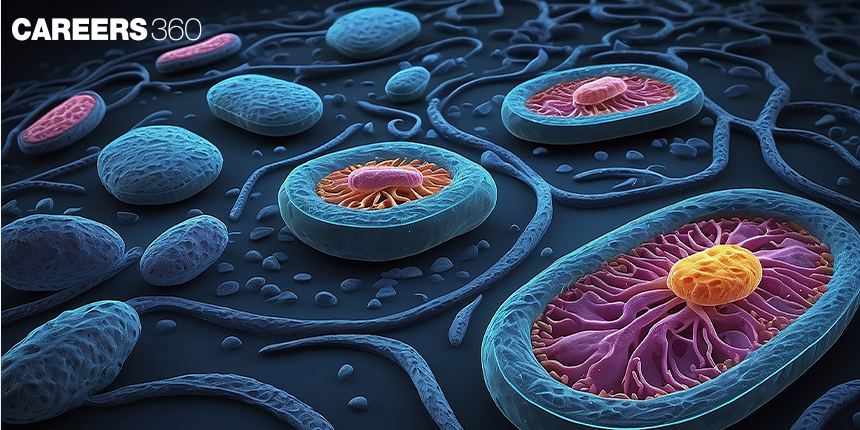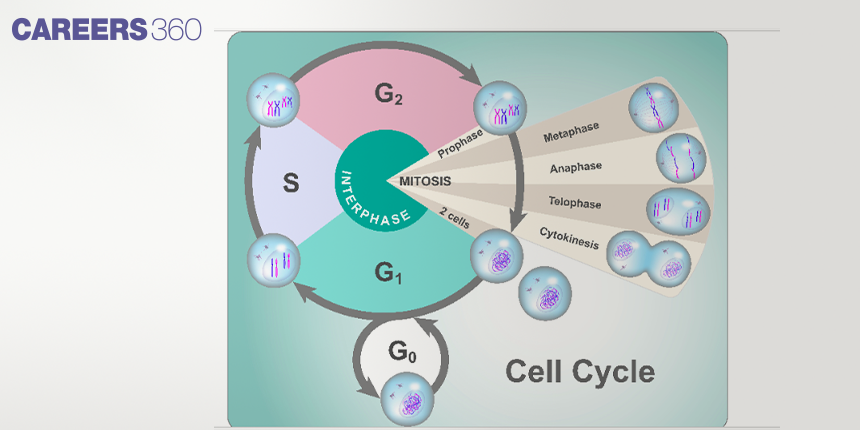Cell Division: Definition, Stages, Diagram, Phases and FAQ
Cell Division is the process where one cell divides into two new cells that are genetically identical to itself. It is the only method through which an organism grows, develops, or repairs tissues. Cell division takes place in a process called mitosis and meiosis. These two processes contribute differently to reproduction and growth. This topic of Biology is important for competitive exams like NEET, and AIIMS BSc nursing as the questions often come from cell division, mainly because of its biological importance.
NEET 2025: Mock Test Series | Syllabus | High Scoring Topics | PYQs
NEET Important PYQ's Subject wise: Physics | Chemistry | Biology
New: Meet Careers360 B.Tech/NEET Experts in your City | Book your Seat now
- What is Cell Division?
- Types of Cell Division
- Phases of Cell Cycle
- Differences between Mitosis and Meiosis
- Phases of Mitosis
- Control and Regulation of Cell Division
- Significance and Applications of Cell Division
- Recommended video for Cell Division

What is Cell Division?
Cell division is a process in which a parent cell divides to produce two or more daughter cells. Separation occurs such that, at the same time, the latter inherits the genetic material brought from the division. In other words, cell division is a basic process by which the organism is continuously developed, grown, and repaired. Cell division for growth results in the increase of cell populations, and by doing so, an organism attains its final size. Primarily, successful regulation of the cell division process as an organism enables tissues and organs to differentiate into diverse functional units. Secondly, in restorative processes, for example, healing, cellular division of cells replaces damaged and lost cells in such a manner that tissue integrity is maintained.
Types of Cell Division
There are two major types of cell division: mitosis and meiosis.
Mitosis yields a division of somatic cells, therefore ensuring each daughter cell is a replica of the parent cell. It is very essential for the sustenance of tissues and the asexual reproduction of an organism.
Meiosis takes place in the respective speciality cells to form gametes with half the number of chromosomes in the parent cell. This process leads to sexual reproduction and genetic diversity in the offspring.
Both processes involved in cell division hold a significant part in the life cycles of organisms, which is a potent tool for growth, reproduction, and adaptation.
Phases of Cell Cycle
The cell cycle is the series of events through which a cell passes through cell division and duplication. It has four main phases:
G1 Phase (Gap 1)
The cell grows and performs all the proper cellular functions. It prepares for DNA duplication.
S Phase (Synthesis)
The chromosomes in the cell divide so that each of the two daughter cells will have the complete set of chromosomes.
G2 Phase (Gap 2)
The cell grows during this subphase, and it prepares for mitosis by synthesizing proteins and organelles.
M Phase (Mitosis)
The cell divides into two daughter nuclei. This process incorporates prophase, metaphase, anaphase, and telophase.
The diagram below indicates the different stages of a cell cycle

Differences between Mitosis and Meiosis
Mitosis is the process taking place in somatic cells. It involves growth, tissue repair, and asexual reproduction. Since it forms two daughter cells, each having the same number of chromosomes (diploid) as the parent cell, the genetic traits of the parent are passed on, and the somatic cells are maintained.
Meiosis occurs in the germ cells, namely the sperm and ova cells, and is central to the process of sexual reproduction. It is the process of two successive cell divisions, resulting in four daughter cells. For the parent cell, in which the number of chromosomes is halved, in other words, haploid. This is vital to ensure that when a sperm or ovum cell fuses to become a zygote, that offspring has the correct chromosome number in the diploid form to be like the rest of the species.
Phases of Mitosis
The four different stages of mitosis are:
Prophase
During this stage, the chromatin condenses and the chromosomes are visible.
The nucleolus disappears, and the nuclear envelope fragments.
With the disappearance of the nuclear membrane, the centrioles migrate to the opposite end, and spindle formation occurs.
Until prophase, the chromosomes have no particular orientation because the spindle has not yet formed.
Metaphase
Chromosomes become fully condensed and distinct.
Chromosomes move towards the equatorial plane of spindles or metaphase plates.
Chromosomes are arranged with their arms directed towards the pole and centromere towards the equator.
AnaphaseThe centromere splits, and the two chromatids of the duplicated chromosomes separate from each other.
Each chromatid now becomes a daughter chromosome.
Daughter chromosomes, each with a centromere and single chromatid, appear to move towards opposite poles.
Anaphase is the shortest phase of mitosis.
Telophase
During this phase, the spindle disappears and new nuclear envelopes develop around the daughter chromosomes.
Each daughter nucleus contains the same number and kinds of chromosomes as the original parent cell.
The chromosomes become diffuse chromatin and nucleolus reappears.
It is followed by the division of the cytoplasm.
Control and Regulation of Cell Division
The process of cell division is very critical since strictly controlled and well-regulated pathways allow these processes to take place. Among these checkpoints are the G1/S checkpoint, G2/M checkpoint, and spindle checkpoint—all regulating critical events and conditions that have to be checked off before entry to the next cell cycle stage. Such checkpoints that delineate cell cycle progression are under the control of master regulators like the cyclins and CDKs. In this manner, their correct sequentiality ensures that the process of DNA replication is done properly to avoid mistakes that might eventually lead to genomic instability.
Significance and Applications of Cell Division
Cell division is an indispensable process for many different biological phenomena. It is prominently engaged in an increase in size, development, growth, tissue repair, regeneration, and asexual reproduction. Cell division with growth and development enables an organism to get bigger and more complex by the creation of new cells. This includes the differentiated ones. In tissue repair and regeneration, cell division replaces damaged or lost cells and, therefore, restitutes tissue function and integrity. In asexual reproduction, it is the cell division that produces the offspring with a combination of genes in its structure that closely resembles that of its parent. It eventually assures rapid growth in population and survival under favourable conditions. Cell division is a crucial and absolute process in the maintenance, repair, and reproduction of organisms; it represents a fundamental, universal feature of life.
Also Read:
| Meiosis I | Meiosis II |
| Difference between Mitosis and Meiosis | Difference between Karyokinesis and Cytokinesis |
| Bacterial Cell Division | Nucleus |
Recommended video for Cell Division
Frequently Asked Questions (FAQs)
It serves for the growth, repair, and reproduction of organisms. It also provides the genetic continuity that is necessary when a parent cell divides to give two daughter cells.
Mitosis consists of prophase, metaphase, anaphase, and telophase, culminating in cytokinesis.
The process of mitosis takes place within somatic cells and results in two identical diploid daughter cells, identical to the parent cell. Meiosis is a process that occurs in germ cells. It leads to four haploid daughter cells, each with its own, different genetic makeup.
Checkpoints known as G1/S, G2/M, and spindle monitor cell cycle progress, and proper cell division.
Errors in cell division can lead to various diseases and abnormalities, like cancer and Down syndrome.
Also Read
13 Nov'24 09:49 AM
09 Nov'24 08:30 AM
05 Nov'24 03:55 PM
18 Sep'24 05:46 PM
18 Sep'24 05:30 PM
18 Sep'24 03:18 PM
18 Sep'24 01:57 PM



